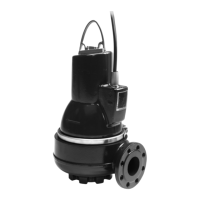English (GB)
12
Installation types
SL1 and SLV pumps are designed for two installation
types:
• submerged installation on auto coupling
• free-standing submerged installation on ring
stand.
7.1 Submerged installation on auto
coupling
Fig. 4 Submerged installation on auto coupling
Pumps for permanent installation can be installed on
a stationary auto-coupling guide rail system. The
auto-coupling system facilitates maintenance and
service as the pump can easily be lifted out of the
tank.
Proceed as follows:
1. Drill mounting holes for the guide rail bracket on
the inside of the tank and fasten the guide rail
bracket provisionally with two screws.
2. Place the auto-coupling base unit on the bottom
of the tank. Use a plumb line to establish the
correct positioning. Fasten the auto coupling with
expansion bolts. If the bottom of the tank is
uneven, the auto-coupling base unit must be
supported so that it is level when being fastened.
3. Assemble the outlet pipe in accordance with the
generally accepted procedures and without
exposing the pipe to distortion or tension.
4. Place the guide rails on the auto-coupling base
unit and adjust the length of the rails accurately
to the guide rail bracket at the top of the tank.
5. Unscrew the provisionally fastened guide rail
bracket. Insert the upper guide rail bracket into
the guide rails. Fasten the guide rail bracket on
the inside of the tank.
?
6. Clean out debris from the tank before lowering
the pump into the tank.
7. Fit the guide claw to the outlet port of the pump.
8. Slide the guide claw of the pump between the
guide rails and lower the pump into the tank by
means of a chain secured to the lifting bracket of
the pump. When the pump reaches the auto-
coupling base unit, the pump will automatically
connect tightly.
9. Hang up the end of the chain on a suitable hook
at the top of the tank and in such a way that the
chain cannot come into contact with the pump
housing.
10. Adjust the length of the power cable by coiling it
up on a relief fitting to ensure that the cable is not
damaged during operation. Fasten the relief
fitting to a suitable hook at the top of the tank.
Make sure that the cables are not sharply bent or
pinched.
11. Connect the power cable.
TM04 2650 2808
Before beginning installation procedures,
make sure that the atmosphere in the tank
is not potentially explosive.
Inspect the oil level and condition every
3000 operating hours or at least once a
year.
When the pump is new or after
replacement of the shaft seal, check the oil
level and water content after one week of
operation.
Make sure that the pipes are installed
without the use of undue force. No loads
from the weight of the pipes must be
carried by the pump. We recommend that
you use loose flanges to ease the
installation and to avoid pipe tension at
flanges and bolts.
Do not use elastic elements or bellows in
the pipes. These elements must never be
used as a means to align the pipes.
The guide rails must not have any axial
play as this would cause noise during
pump operation.
The free end of the cable must not be
submerged, as water may penetrate into
the cable.

